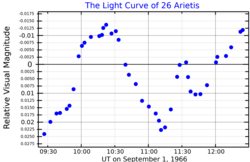 A visual band light curve for 26 Arietis, adapted from Breger (1969) | |
| Observation data Epoch J2000 Equinox J2000 | |
|---|---|
| Constellation | Aries |
| Right ascension | 02 30 38.41727 |
| Declination | +19° 51′ 19.0917″ |
| Apparent magnitude (V) | 6.10 - 6.15 |
| Characteristics | |
| Spectral type | A9 V |
| U−B color index | +0.102 |
| B−V color index | +0.248 |
| Variable type | Delta Scuti variable |
| Astrometry | |
| Radial velocity (Rv) | +15.0 km/s |
| Proper motion (μ) | RA: +79.814 mas/yr Dec.: −34.746 mas/yr |
| Parallax (π) | 13.7810 ± 0.0831 mas |
| Distance | 237 ± 1 ly (72.6 ± 0.4 pc) |
| Absolute magnitude (MV) | 1.89 |
| Details | |
| Mass | 1.74 M☉ |
| Radius | 2.32+0.11 −0.12 R☉ |
| Luminosity | 15 L☉ |
| Surface gravity (log g) | 3.84 cgs |
| Temperature | 7,430 K |
| Rotational velocity (v sin i) | 186 km/s |
| Age | 1.075 Gyr |
| Other designations | |
| 26 Ari, UU Arietis, BD+19°365, FK5 2172, HD 15550, HIP 11678, HR 729, SAO 92979 | |
| Database references | |
| SIMBAD | data |
26 Arietis is a variable star in the northern constellation of Aries. 26 Arietis is the Flamsteed designation; it also bears the variable star designation UU Arietis. The apparent visual magnitude of this star is 6.14, which, according to the Bortle Dark-Sky Scale, is within the naked eye visibility limit in dark rural skies. The annual parallax shift of 13.78 mas is equivalent to a distance of approximately 215 light-years (66 parsecs) from Earth. The star is receding from the Earth with a heliocentric radial velocity of +15 km/s.
Michel Breger discovered that 36 Arietis is a variable star in 1969. It was given its variable star designation in 1970. It is a Delta Scuti variable with a variability period of 0.0676 days and an amplitude of 0.010 in magnitude. It is an A-type main sequence star with a stellar classification of A9 V. The star is around a billion years old with 1.74 times the mass of the Sun and 2.32 times the Sun's radius. The star is radiating 15 times the luminosity of the Sun from its photosphere at an effective temperature of 7,430 K.
References
- Breger, M. (March 1969). "Short-period variability of B, A, and F stars. II. Photometry of new Delta Scuti stars". The Astronomical Journal. 74 (1): 166–176. Bibcode:1969AJ.....74..166B. doi:10.1086/110788. Retrieved 27 October 2021.
- ^ Brown, A. G. A.; et al. (Gaia collaboration) (August 2018). "Gaia Data Release 2: Summary of the contents and survey properties". Astronomy & Astrophysics. 616. A1. arXiv:1804.09365. Bibcode:2018A&A...616A...1G. doi:10.1051/0004-6361/201833051. Gaia DR2 record for this source at VizieR.
- ^ Samus, N. N.; Durlevich, O. V.; et al. (2009), "VizieR Online Data Catalog: General Catalogue of Variable Stars (Samus+ 2007-2013)", VizieR On-line Data Catalog: B/GCVS. Originally Published in: 2009yCat....102025S, 1: B/gcvs, Bibcode:2009yCat....102025S.
- ^ Palmer, D. R.; et al. (1968), "The radial velocities spectral types and projected rotational velocities of 633 bright northern A stars", Royal Observatory Bulletin, 135: 385, Bibcode:1968RGOB..135..385P.
- ^ Breger, M. (March 1968), "UBV and narrow-band UVBY photometry of bright stars", Astronomical Journal, 73: 84–85, Bibcode:1968AJ.....73...84B, doi:10.1086/110602.
- ^ Wielen, R.; et al. (1999), "Sixth Catalogue of Fundamental Stars (FK6). Part I. Basic fundamental stars with direct solutions", Veroeffentlichungen des Astronomischen Rechen-Instituts Heidelberg, 35 (35), Astronomisches Rechen-Institut Heidelberg: 1, Bibcode:1999VeARI..35....1W.
- ^ Paunzen, E.; et al. (September 2002), "On the Period-Luminosity-Colour-Metallicity relation and the pulsational characteristics of lambda Bootis type stars", Astronomy and Astrophysics, 392 (2): 515–528, arXiv:astro-ph/0207494, Bibcode:2002A&A...392..515P, doi:10.1051/0004-6361:20020854, S2CID 54666586.
- ^ David, Trevor J.; Hillenbrand, Lynne A. (2015), "The Ages of Early-Type Stars: Strömgren Photometric Methods Calibrated, Validated, Tested, and Applied to Hosts and Prospective Hosts of Directly Imaged Exoplanets", The Astrophysical Journal, 804 (2): 146, arXiv:1501.03154, Bibcode:2015ApJ...804..146D, doi:10.1088/0004-637X/804/2/146, S2CID 33401607.
- Royer, F.; et al. (February 2007), "Rotational velocities of A-type stars. III. Velocity distributions", Astronomy and Astrophysics, 463 (2): 671–682, arXiv:astro-ph/0610785, Bibcode:2007A&A...463..671R, doi:10.1051/0004-6361:20065224, S2CID 18475298.
- "UU Ari". SIMBAD. Centre de données astronomiques de Strasbourg. Retrieved 2012-07-18.
- Breger, M. (March 1969). "Short-period variability of B, A, and F stars. II. Photometry of new Delta Scuti stars". Astronomical Journal. 74: 166–176. Bibcode:1969AJ.....74..166B. doi:10.1086/110788. Retrieved 28 November 2024.
- Kukarkin, B. V.; Kholopov, P. N.; Perova, N. B/ (October 1970). "57th Name-List of Variable Stars" (PDF). Information Bulletin on Variable Stars. 480: 1. Bibcode:1970IBVS..480....1K. Retrieved 28 November 2024.
- Rodríguez, E.; et al. (June 2000), "A revised catalogue of delta Sct stars", Astronomy and Astrophysics Supplement, 144 (3): 469–474, Bibcode:2000A&AS..144..469R, doi:10.1051/aas:2000221, hdl:10261/226673.
External links
| Constellation of Aries | |||||||||||||
|---|---|---|---|---|---|---|---|---|---|---|---|---|---|
| Stars |
| ||||||||||||
| |||||||||||||
| Galaxies |
| ||||||||||||
| |||||||||||||
| |||||||||||||